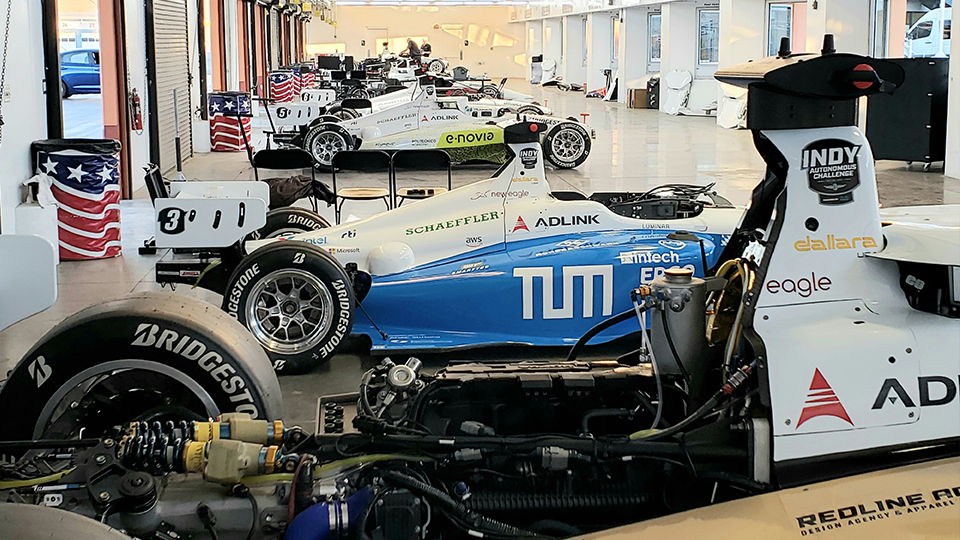Autonomous Racecars to Go Head-to-Head in Vegas
Subscriber Benefit
As a subscriber you can listen to articles at work, in the car, or while you work out. Subscribe Now
Just months after the checkered flag waved on the inaugural Indy Autonomous Challenge Powered by Cisco at the Indianapolis Motor Speedway, organizers are taking the next step in autonomous racing. Indianapolis-based Energy Systems Network has announced nine of the university teams that participated at IMS will seek to compete in a new event at CES 2022 in Las Vegas, which will come with a twist. Instead of a high-speed lap event like what took place in October, the Autonomous Challenge @ CES will be a high-speed, head-to-head passing competition.
ESN President and Chief Executive Officer Paul Mitchell says the idea to bring a race to CES started at the virtual event this year when the autonomous racecar was unveiled.
“The feedback we got from the CES leadership at that event was just tremendous and I think it took our entire storyline of the Indy Autonomous Challenge to a whole new global audience,” said Mitchell. “It really wasn’t until after October 23rd…we still had more to prove – mainly, passing [and] showing cars can operate at the same time and can pass one another.”
Mitchell says having the racecars pass each other in a head-to-head competition was always the goal of the Indy Autonomous Challenge, but they simply ran out of time to make it happen at IMS.
The CES race will take place at Las Vegas Motor Speedway on January 7. The nine university teams seeking to participate in the event are:
- AI Racing Tech – University of Hawai’i (Hawai’i), University of California San Diego (California)
- Autonomous Tiger Racing – Auburn University (Alabama)
- Black & Gold Autonomous Racing – Purdue University (Indiana), United States Military Academy at West Point (New York) with Indiana University-Purdue University Indianapolis (Indiana), Indian Institute of Technology Kharagpur (India), Universidad de San Buenaventura (Colombia)
- Cavalier Autonomous Racing – University of Virginia (Virginia)
- KAIST – Korea Advanced Institute of Science and Technology (South Korea)
- MIT-PITT-RW – Massachusetts Institute of Technology (Massachusetts), University of Pittsburgh (Pennsylvania), Rochester Institute of Technology (New York), University of Waterloo (Canada)
- PoliMOVE – Politecnico di Milano (Italy), University of Alabama (Alabama) (Oct. 23 finalist)
- TII EuroRacing – University of Modena and Reggio Emilia (Italy), Technology Innovation Institute (United Arab Emirates) (Oct. 23 finalist)
- TUM Autonomous Motorsport – Technische Universität München (Germany) (Oct. 23 winner)
Mitchell says the timing of the CES event was perfect, especially considering the team members are still in school.
“These are university-based teams, so they have graduate students and students that are involved. Some of them are graduating. Some of them have to write their dissertations. They have to teach courses. So, we knew that we couldn’t do another event, say, in March or April or even May because you can’t take up another academic semester. We wanted to demonstrate this capability and we needed to do it in a time frame that would allow our teams to get it done and still, in many cases, be a full part of their spring semester of 2022.”
Mitchell says the inaugural competition at IMS was historic for a number of reasons.
“The ability to set records for autonomous vehicles, both in terms of speed, also just the first time anybody had run vehicles in a public setting like that at a famous race track like the Indianapolis Motor Speedway was a thrilling, historic experience,” he said. “But then, on top of that, I think we really grabbed global headlines and global attention not only for the competition that we’ve been working on for the last three years, but for the state of Indiana, the Indianapolis Motor Speedway, as a place where innovation was being showcased and celebrated.”
Governor Eric Holcomb says the IAC keeps Indiana on the global stage with regard to the future of mobility and safety, but it will also lead to growth in innovation.
“I can’t tell you how many times I heard, ‘It’s so awesome this is happening in Indiana,’ and then to hear from the CEO level the number of individuals who said, ‘You know, I want to be a part of this. This is truly how you grow your ecosystem,'” said Holcomb. “And so, this will be good for our universities and colleges. This will be good for industry, as well. To not just be part of the conversation, but to be growing this sector, we have to be a powerhouse in terms of our logistical prowess and on that day, it wasn’t just Munich who won; Indiana did too.”
Mitchell says the head-to-head competition at CES will cap off the years-long journey of the Indy Autonomous Challenge. He says after the event, ESN will continue to have conversations with the state, IMS and other stakeholders about a potential second prize competition.
Mitchell says the idea to bring a race to CES started at the virtual event this year when the autonomous racecar was unveiled.
Mitchell says the inaugural competition at IMS was historic for a number of reasons.
